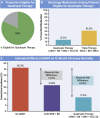Advances in Clinical Cardiology 2024: A Summary of Key Clinical Trials
- PMID: 40388090
- PMCID: PMC12182473
- DOI: 10.1007/s12325-025-03220-9
Advances in Clinical Cardiology 2024: A Summary of Key Clinical Trials
Abstract
Introduction: In 2024, numerous key clinical trials in the field of clinical cardiology have been published or presented at major international conferences. This review seeks to collate and summarise these trials and reflect on their clinical context.
Methods: The authors evaluated all clinical trials presented at major cardiology conferences during 2024 with a focus on clinical trials which would influence and/or change current clinical practice. We reviewed clinical trials presented at all major international conferences including the American College of Cardiology (ACC), European Association for Percutaneous Cardiovascular Interventions (EuroPCR), European Society of Cardiology (ESC), Transcatheter Cardiovascular Therapeutics (TCT), American Heart Association (AHA), European Heart Rhythm Association (EHRA), Society for Cardiovascular Angiography and Interventions (SCAI), TVT-The Heart Summit (TVT) and Cardiovascular Research Technologies (CRT). Trials considered to have highest impact and/or broad relevance across the field of clinical cardiology, with a high likelihood to change or impact upon clinical practice were included.
Results: Over 90 key cardiology clinical trials were identified across the spectrum of clinical cardiology. Important updates in percutaneous coronary intervention were reviewed including new ESC guidance and several key trials in the field of coronary physiology (FAVOR III), drug-coated balloons (REGCAGE-FREE, AGENT-IDE), shock, and acute coronary syndromes (SENIOR-RITA, DanGer-Shock). Structural trials included major updates in transcatheter aortic valve replacement (TAVR) from EARLY-TAVR, TAVR-UNLOAD and NOTION 3, as well as seminal trials in tricuspid (TRISCEND II) and mitral intervention (MATTERHORN). Key updates in preventative cardiology included new data in lipoprotein (a) pharmacotherapy, low-density lipoprotein (LDL) cholesterol reduction and hypertension management (BPROAD, BedMed, KRAKEN), as well as several key trials in heart failure (SUMMIT, FINEARTS) hypertrophic cardiomyopathy (SEQUOIA-HCM) and cardiac amyloid (HELIOS-B).
Conclusion: The review presents a concise summary of the key clinical cardiology trials published or presented during the past year and should be of interest to clinicians and researchers in the field of cardiology.
Keywords: Acute coronary syndromes; Cardiology; Clinical trials; Electrophysiology; Heart failure; Intervention; Prevention; Structural.
© 2025. The Author(s).
Conflict of interest statement
Declarations. Conflict of Interest: Ian Menown has received grants to institution, honoraria and/or conference sponsorship from Biosensors and Novartis. Ian Menown is an editorial board member of Advances in Therapy. Ian Menown was not involved in the selection of peer reviewers for the manuscript nor any of the subsequent editorial decisions. Patrick Savage, Michael Campbell, Daniel McElhatton and Meadhbh Hogg have nothing to disclose. Ethical Approval: This article is based on previously conducted studies and does not involve any new studies of human or animal subjects performed by any of the authors.
Figures



Similar articles
-
Advances in Clinical Cardiology 2021: A Summary of Key Clinical Trials.Adv Ther. 2022 Jun;39(6):2398-2437. doi: 10.1007/s12325-022-02136-y. Epub 2022 Apr 28. Adv Ther. 2022. PMID: 35482250 Free PMC article. Review.
-
Advances in Clinical Cardiology 2023: A Summary of Key Clinical Trials.Adv Ther. 2024 Jul;41(7):2606-2634. doi: 10.1007/s12325-024-02877-y. Epub 2024 May 14. Adv Ther. 2024. PMID: 38743242 Free PMC article. Review.
-
Advances in Clinical Cardiology 2022: A Summary of Key Clinical Trials.Adv Ther. 2023 Jun;40(6):2595-2625. doi: 10.1007/s12325-023-02502-4. Epub 2023 Apr 13. Adv Ther. 2023. PMID: 37052800 Free PMC article. Review.
-
Systemic pharmacological treatments for chronic plaque psoriasis: a network meta-analysis.Cochrane Database Syst Rev. 2021 Apr 19;4(4):CD011535. doi: 10.1002/14651858.CD011535.pub4. Cochrane Database Syst Rev. 2021. Update in: Cochrane Database Syst Rev. 2022 May 23;5:CD011535. doi: 10.1002/14651858.CD011535.pub5. PMID: 33871055 Free PMC article. Updated.
-
Systemic pharmacological treatments for chronic plaque psoriasis: a network meta-analysis.Cochrane Database Syst Rev. 2017 Dec 22;12(12):CD011535. doi: 10.1002/14651858.CD011535.pub2. Cochrane Database Syst Rev. 2017. Update in: Cochrane Database Syst Rev. 2020 Jan 9;1:CD011535. doi: 10.1002/14651858.CD011535.pub3. PMID: 29271481 Free PMC article. Updated.
Cited by
-
Mid-term outcomes of robotic assisted versus conventional sternotomy for mitral valve replacement: a nationwide propensity-weighted analysis using Taiwan's National Health Insurance Research Database.J Robot Surg. 2025 Jul 16;19(1):396. doi: 10.1007/s11701-025-02564-2. J Robot Surg. 2025. PMID: 40670881 Free PMC article.
References
-
- Vrints C, Andreotti F, Koskinas KC, et al. 2024 ESC guidelines for the management of chronic coronary syndromes: developed by the task force for the management of chronic coronary syndromes of the European society of cardiology (ESC) endorsed by the European Association for Cardio-Thoracic Surgery (EACTS). Eur Heart J. 2024;45(36):3415–537. - PubMed
-
- Mack MJ, Fullerton DA, Fann JI. The answers you get depend on the questions you ask: insights from the recent EXCEL trial controversy. Ann Thorac Surg. 2021;111(6):1743–5. - PubMed
-
- Sabatine MS, Bergmark BA, Murphy SA, et al. Percutaneous coronary intervention with drug-eluting stents versus coronary artery bypass grafting in left main coronary artery disease: an individual patient data meta-analysis. Lancet. 2021;398(10318):2247–57. - PubMed
-
- Kunadian V, Mossop H, Shields C, et al. Invasive treatment strategy for older patients with myocardial infarction. N Engl J Med. 2024;391(18):1673–84. - PubMed
-
- Campo G, Böhm F, Engstrøm T, et al. Complete versus culprit-only revascularization in older patients with ST-segment-elevation myocardial infarction: an individual patient meta-analysis. Circulation. 2024;150(19):1508–16. - PubMed
Publication types
MeSH terms
LinkOut - more resources
Full Text Sources
Medical
Research Materials
Miscellaneous

